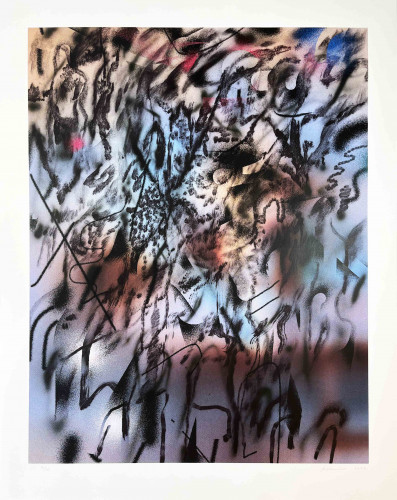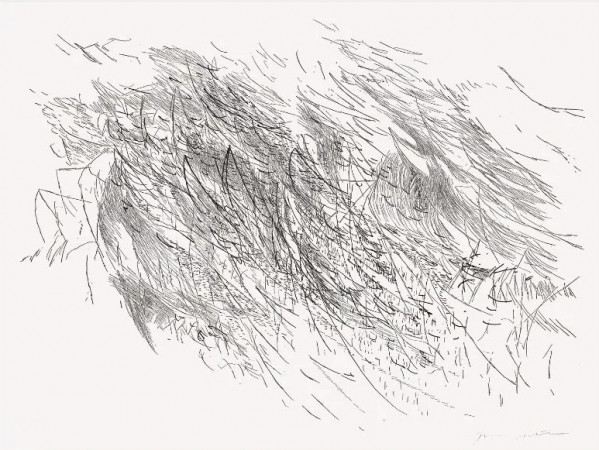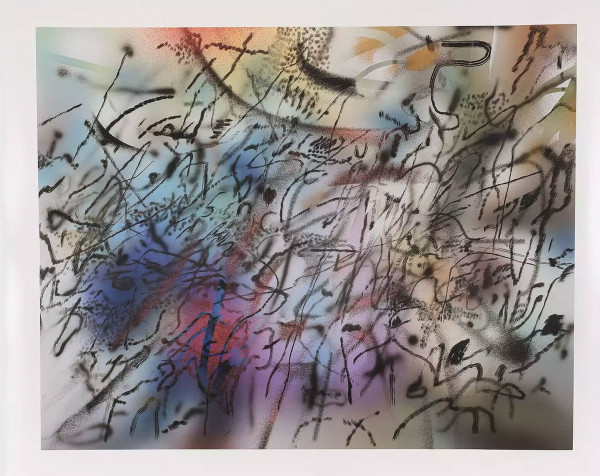Julie Mehretu: Mapping Chaos, Layering History

By Emilia Novak
Buildings, streets, and entire cities crash into one another – such is the sensation of standing before a Julie Mehretu painting. Black scribbles and bold flashes of color careen across a vast canvas, creating an almost overwhelming kaleidoscope of motion. This organized chaos is the signature of Julie Mehretu, an Ethiopian-American artist whose monumental, layered abstractions have made her a global figure in contemporary art. Her canvases combine the structural lines of city grids, architectural blueprints, and maps to create dense, three-dimensional compositions that convey the frenzy of the modern urban experience. Over the past two decades, Mehretu has been celebrated as one of the most significant painters of her generation, credited with giving new life to abstraction. In this article, we journey through her life and work – from Addis Ababa to New York – to understand her artistic significance. Through storytelling and insight, we’ll see how Mehretu’s “abstract cartographies” map not only geography and history, but also the turbulent energies of our present world, subtly illuminating why her works have become so sought-after by collectors and institutions alike.
From Addis Ababa to New York
Born in 1970 in Addis Ababa to an Ethiopian professor and an American Montessori teacher, Mehretu's early life was shaped by political unrest. Her family fled Ethiopia during the rise of the Derg regime in the late 1970s, resettling in Michigan. This dislocation—between continents, cultures, and identities—left a lasting mark. Mehretu often speaks of being shaped by a sense of “constant negotiation” between places and ideals.
She studied at Kalamazoo College and spent time at the University of Cheikh Anta Diop in Senegal before completing her MFA at the Rhode Island School of Design in 1997. There, she began developing a language of abstraction rooted in cartography, memory, and movement. Early drawings of clustered ink marks evolved into aerial landscapes—what she called “story maps of no location.”
Architecture, migration, and layered identity soon became the conceptual scaffolding of her work. By the time of her residencies at the Core Program in Houston and the Studio Museum in Harlem, Mehretu had begun forging a singular style: abstraction charged with political meaning, rendered through architectural geometry and gestural spontaneity.
A Unique Visual Language
Mehretu’s technique is a feat of construction. She often starts with digitally projected architectural blueprints—stadiums, skyscrapers, city grids—mapped onto massive canvases. Over these foundations, she adds translucent color washes, then floods the surface with her own drawn marks: swirls, scratches, hatches, and lines that suggest graffiti, calligraphy, weather patterns, or topographies.
These layers are built up, sealed, sometimes erased, and redrawn over weeks or months. The result is a painting that looks both planned and improvised—an abstract document of forces at play. Critics have called her work “calligraphic complexity,” a visual equivalent of urban density, data overload, and geopolitical tension.
Though she embraces digital tools—Photoshop distortions, projection mapping—her work always returns to the hand. The physicality of drawing remains central. Her canvases seem to breathe: dense with marks, yet somehow in motion.
Breakthroughs and Major Works
Mehretu rose to prominence in the early 2000s with the Stadia series (2004), which imagined architectural arenas—echoing stadiums and political spaces—infused with the energy of crowds, nation-states, and corporate logos. These works, exhibited internationally, captured the spectacle and structure of collective life.
Her 2009 commission for Goldman Sachs’s New York headquarters, the monumental Mural, layered historical architecture with fractured marks that suggested the turbulence of capitalism itself. That same year, her Grey Area series for Berlin’s Deutsche Guggenheim explored memory and loss in the city’s architecture.
Mehretu's 2012 series Mogamma (A Painting in Four Parts) remains among her most powerful. Inspired by the Arab Spring, the series fuses drawings of civic squares from Cairo, Addis Ababa, Beijing, and New York, overlaid with expressive, chaotic gestures that evoke the emotional texture of revolution.
By the 2010s, major institutions and collectors had taken notice. MoMA, the Whitney, and the Walker Art Center acquired her work. In 2005, she received a MacArthur “genius” grant. In 2023, her painting set an auction record at $10.7 million—the highest ever for an African-born artist.
Abstraction as Protest
Though abstract, Mehretu’s paintings are deeply political. She doesn’t depict events, but her work absorbs them. Layers of architectural imagery hint at power structures—colonial palaces, financial towers, protest sites—while her mark-making channels the forces of disruption and change.
The Mogamma series epitomizes this: urban façades become sites of resistance, and no single location dominates. Instead, histories overlap—Red Square, Tiananmen, Tahrir, Zuccotti—all merging in a shared topography of unrest.
Her work addresses questions of civic identity, migration, and empire. Stadiums and squares become symbols of both control and collective agency. Her abstract gestures suggest flight paths, refugee routes, or protest slogans—open to interpretation, but undeniably charged.
“I don’t illustrate events,” Mehretu has said, “but I’m informed by them.” Her art doesn’t dictate meaning; it invites it. This ambiguity allows the viewer to project their own associations and emotional readings, making her work both global and personal.
Adapting to the Now
In recent years, Mehretu has adapted her methods to confront the volatility of the present. During the 2020–21 Whitney Museum retrospective, she debuted new paintings incorporating blurred photojournalistic imagery—riots, police clashes, border protests—screen-printed beneath veils of abstraction.
In these pieces, the ghosts of real events flicker beneath smoky washes and fierce lines, just visible but unreachable. It’s a metaphor for how we consume trauma today: through media, through distance, through distortion.
Formally, too, her work has shifted. The newer paintings are looser, moodier. The architectural clarity of earlier pieces gives way to foggier, more atmospheric effects—blended grays, bursts of acidic color, marks that float or sink rather than clash.
This evolution reflects not retreat but recalibration. In a time of fractured truths and emotional fatigue, Mehretu’s abstraction insists on slow engagement. Her paintings don’t offer easy answers; they demand contemplation.
A Mirror for Our Times
Mehretu’s work is timely not because it responds directly to headlines, but because it reflects the structure of the moment: layered, unstable, and interconnected. In her canvases, the rhythms of globalization—migration, urbanization, resistance, data, dislocation—take on form.
Her art speaks to the experience of living in an overstimulated, oversaturated world. One can read it as an archive of human motion: how we build, flee, protest, and rebuild again. Her layered surfaces recall the noise of digital feeds, the weight of history, and the echo of forgotten voices.
And yet, within the chaos, there is clarity. Mehretu's paintings don’t just map crisis—they also map resilience, creativity, and continuity. In their motion is memory. In their abstraction is agency. And in their density, a strange lightness: the possibility of reimagining space, identity, and meaning.
Final Thought
Julie Mehretu’s art captures the pulse of our century—not with narrative, but with energy, depth, and vision. For collectors and viewers alike, her work is not only a bold visual statement but a resonant cultural document. To stand before a Mehretu painting is to confront the complexity of our world—and to recognize, within its layered chaos, the beauty of connection.
By Emilia Novak
Buildings, streets, and entire cities crash into one another – such is the sensation of standing before a Julie Mehretu painting. Black scribbles and bold flashes of color careen across a vast canvas, creating an almost overwhelming kaleidoscope of motion. This organized chaos is the signature of Julie Mehretu, an Ethiopian-American artist whose monumental, layered abstractions have made her a global figure in contemporary art. Her canvases combine the structural lines of city grids, architectural blueprints, and maps to create dense, three-dimensional compositions that convey the frenzy of the modern urban experience. Over the past two decades, Mehretu has been celebrated as one of the most significant painters of her generation, credited with giving new life to abstraction. In this article, we journey through her life and work – from Addis Ababa to New York – to understand her artistic significance. Through storytelling and insight, we’ll see how Mehretu’s “abstract cartographies” map not only geography and history, but also the turbulent energies of our present world, subtly illuminating why her works have become so sought-after by collectors and institutions alike.
From Addis Ababa to New York
Born in 1970 in Addis Ababa to an Ethiopian professor and an American Montessori teacher, Mehretu's early life was shaped by political unrest. Her family fled Ethiopia during the rise of the Derg regime in the late 1970s, resettling in Michigan. This dislocation—between continents, cultures, and identities—left a lasting mark. Mehretu often speaks of being shaped by a sense of “constant negotiation” between places and ideals.
She studied at Kalamazoo College and spent time at the University of Cheikh Anta Diop in Senegal before completing her MFA at the Rhode Island School of Design in 1997. There, she began developing a language of abstraction rooted in cartography, memory, and movement. Early drawings of clustered ink marks evolved into aerial landscapes—what she called “story maps of no location.”
Architecture, migration, and layered identity soon became the conceptual scaffolding of her work. By the time of her residencies at the Core Program in Houston and the Studio Museum in Harlem, Mehretu had begun forging a singular style: abstraction charged with political meaning, rendered through architectural geometry and gestural spontaneity.
A Unique Visual Language
Mehretu’s technique is a feat of construction. She often starts with digitally projected architectural blueprints—stadiums, skyscrapers, city grids—mapped onto massive canvases. Over these foundations, she adds translucent color washes, then floods the surface with her own drawn marks: swirls, scratches, hatches, and lines that suggest graffiti, calligraphy, weather patterns, or topographies.
These layers are built up, sealed, sometimes erased, and redrawn over weeks or months. The result is a painting that looks both planned and improvised—an abstract document of forces at play. Critics have called her work “calligraphic complexity,” a visual equivalent of urban density, data overload, and geopolitical tension.
Though she embraces digital tools—Photoshop distortions, projection mapping—her work always returns to the hand. The physicality of drawing remains central. Her canvases seem to breathe: dense with marks, yet somehow in motion.
Breakthroughs and Major Works
Mehretu rose to prominence in the early 2000s with the Stadia series (2004), which imagined architectural arenas—echoing stadiums and political spaces—infused with the energy of crowds, nation-states, and corporate logos. These works, exhibited internationally, captured the spectacle and structure of collective life.
Her 2009 commission for Goldman Sachs’s New York headquarters, the monumental Mural, layered historical architecture with fractured marks that suggested the turbulence of capitalism itself. That same year, her Grey Area series for Berlin’s Deutsche Guggenheim explored memory and loss in the city’s architecture.
Mehretu's 2012 series Mogamma (A Painting in Four Parts) remains among her most powerful. Inspired by the Arab Spring, the series fuses drawings of civic squares from Cairo, Addis Ababa, Beijing, and New York, overlaid with expressive, chaotic gestures that evoke the emotional texture of revolution.
By the 2010s, major institutions and collectors had taken notice. MoMA, the Whitney, and the Walker Art Center acquired her work. In 2005, she received a MacArthur “genius” grant. In 2023, her painting set an auction record at $10.7 million—the highest ever for an African-born artist.
Abstraction as Protest
Though abstract, Mehretu’s paintings are deeply political. She doesn’t depict events, but her work absorbs them. Layers of architectural imagery hint at power structures—colonial palaces, financial towers, protest sites—while her mark-making channels the forces of disruption and change.
The Mogamma series epitomizes this: urban façades become sites of resistance, and no single location dominates. Instead, histories overlap—Red Square, Tiananmen, Tahrir, Zuccotti—all merging in a shared topography of unrest.
Her work addresses questions of civic identity, migration, and empire. Stadiums and squares become symbols of both control and collective agency. Her abstract gestures suggest flight paths, refugee routes, or protest slogans—open to interpretation, but undeniably charged.
“I don’t illustrate events,” Mehretu has said, “but I’m informed by them.” Her art doesn’t dictate meaning; it invites it. This ambiguity allows the viewer to project their own associations and emotional readings, making her work both global and personal.
Adapting to the Now
In recent years, Mehretu has adapted her methods to confront the volatility of the present. During the 2020–21 Whitney Museum retrospective, she debuted new paintings incorporating blurred photojournalistic imagery—riots, police clashes, border protests—screen-printed beneath veils of abstraction.
In these pieces, the ghosts of real events flicker beneath smoky washes and fierce lines, just visible but unreachable. It’s a metaphor for how we consume trauma today: through media, through distance, through distortion.
Formally, too, her work has shifted. The newer paintings are looser, moodier. The architectural clarity of earlier pieces gives way to foggier, more atmospheric effects—blended grays, bursts of acidic color, marks that float or sink rather than clash.
This evolution reflects not retreat but recalibration. In a time of fractured truths and emotional fatigue, Mehretu’s abstraction insists on slow engagement. Her paintings don’t offer easy answers; they demand contemplation.
A Mirror for Our Times
Mehretu’s work is timely not because it responds directly to headlines, but because it reflects the structure of the moment: layered, unstable, and interconnected. In her canvases, the rhythms of globalization—migration, urbanization, resistance, data, dislocation—take on form.
Her art speaks to the experience of living in an overstimulated, oversaturated world. One can read it as an archive of human motion: how we build, flee, protest, and rebuild again. Her layered surfaces recall the noise of digital feeds, the weight of history, and the echo of forgotten voices.
And yet, within the chaos, there is clarity. Mehretu's paintings don’t just map crisis—they also map resilience, creativity, and continuity. In their motion is memory. In their abstraction is agency. And in their density, a strange lightness: the possibility of reimagining space, identity, and meaning.
Final Thought
Julie Mehretu’s art captures the pulse of our century—not with narrative, but with energy, depth, and vision. For collectors and viewers alike, her work is not only a bold visual statement but a resonant cultural document. To stand before a Mehretu painting is to confront the complexity of our world—and to recognize, within its layered chaos, the beauty of connection.
















